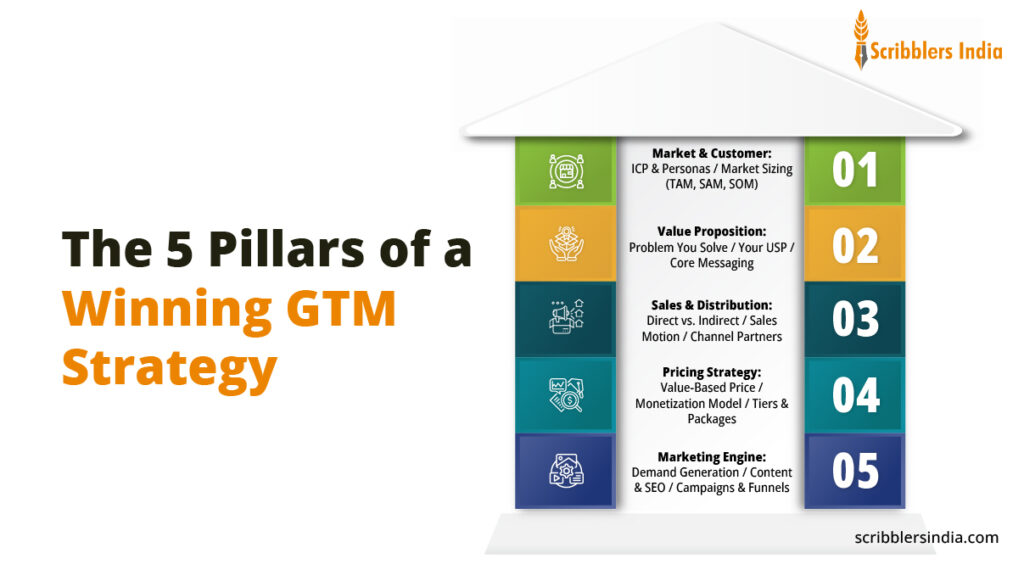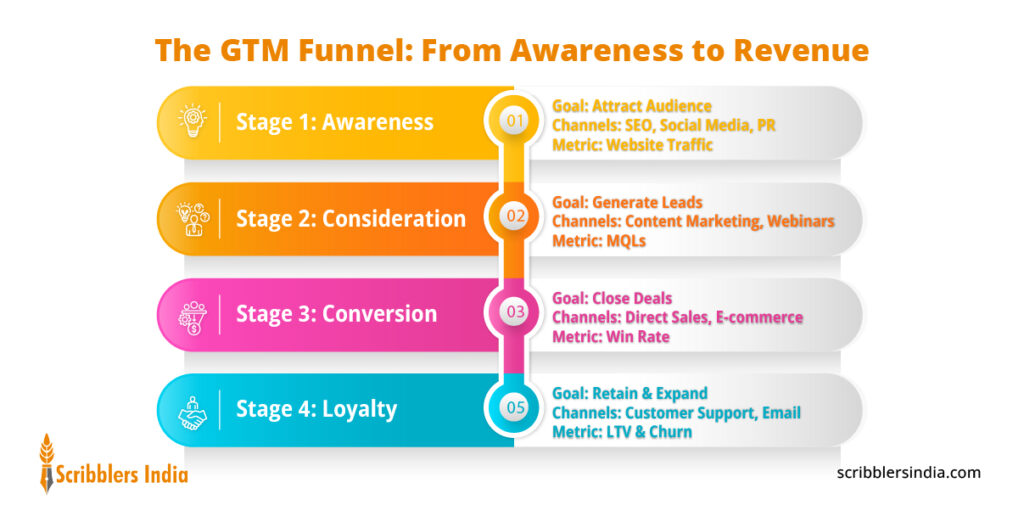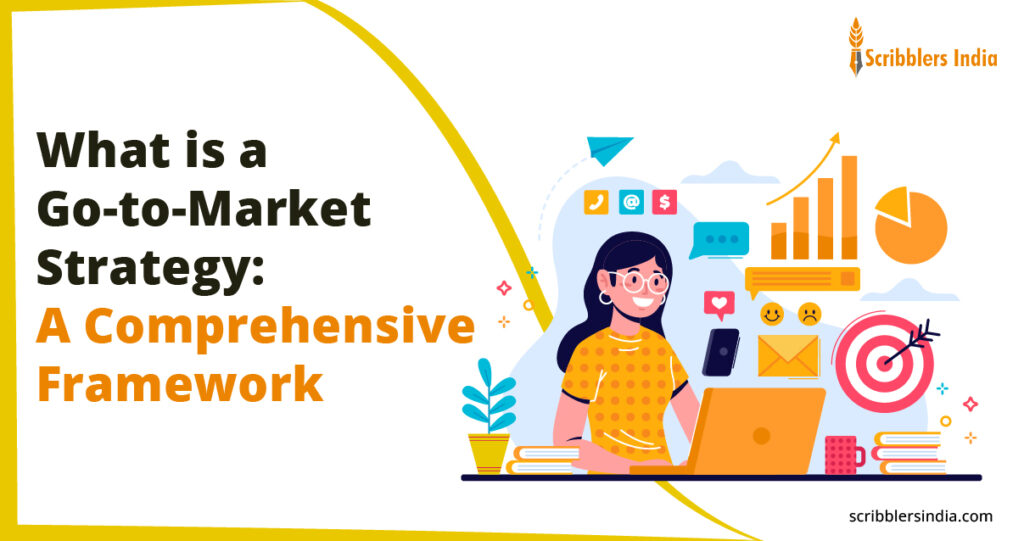You have built an incredible product or service. The features are polished, the design is intuitive, and you know it can solve a real problem. But a critical question remains: how do you actually get it into the hands of the right people? This gap between a finished product and a paying customer is where many brilliant ideas falter. This is precisely where a Go-to-Market (GTM) strategy comes into play.
A GTM strategy is a comprehensive blueprint that details how you will engage with customers to achieve a competitive advantage. It aligns all your business functions to a single goal.
Without this strategic map, you risk low product adoption, misaligned sales and marketing efforts, and significant wasted resources. We have previously explored how to create a GTM strategy and the role content plays within it. Now, we will dive deep into the complete GTM strategy framework. This guide will demystify its core components and show you how to build a powerful plan for market success.
Why I Cannot Launch My Product Without a GTM Strategy?
A product “launch” is a single event, while a Go-to-Market strategy is the entire, overarching plan that ensures the launch is successful and sustainable. Launching without a GTM strategy is like setting sail without a map, a compass, or a destination in mind. You might create some initial waves, but you will likely end up lost.
The core reason why a content-led GTM strategy is important is that it forces you to answer critical questions before you commit your time and budget. A study from Gartner reveals that companies often focus too much on product creation and not enough on market delivery, which is a key reason for failure. An effective go-to-market plan mitigates this risk.
Common Mistakes Without a GTM Strategy
- Scattered Marketing: You market to everyone, which means you connect with no one, wasting valuable resources.
- Misaligned Teams: Your marketing and sales teams work in silos, with different goals and messaging.
- Weak Value Proposition: Customers do not understand why your product is a better choice than the alternatives.
- No Clear Metrics: You cannot define what success looks like, making it impossible to track progress or pivot.
- Wasted Budget: You spend money on channels and tactics that do not reach your ideal customer or drive results.
Think of your GTM strategy as a GPS for your product. It does not just point you in a general direction; it gives you turn-by-turn instructions to reach your destination efficiently.
What Are the Core Pillars of a Successful Go-to-Market Strategy?
A successful strategy is built on five foundational pillars that provide structure and clarity. These elements of a GTM strategy ensure you have a holistic view of the market and a clear path forward. Each pillar addresses a critical component of bringing your product to your customers effectively.
These GTM strategy components are interconnected. A deep understanding of your market informs your value proposition, which then guides your channel selection, pricing, and marketing efforts.
Pillar 1: Market & Customer Understanding
This is the bedrock of your entire strategy. You must first define the playground and the players. It involves understanding where you will compete and who you will serve.
- Market Analysis: Define your Total Addressable Market (TAM), Serviceable Available Market (SAM), and Serviceable Obtainable Market (SOM) to size your opportunity.
- Ideal Customer Profile (ICP): Go beyond basic demographics to create a detailed profile of the perfect customer for your product.
Pillar 2: Value Proposition & Messaging
This pillar defines why a customer should choose you. It is the core of your communication and differentiation in a crowded marketplace.
- Problem-Solution Fit: Clearly articulate the problem you solve and how your product provides the ideal solution.
- Compelling Messaging: Craft a clear, consistent, and persuasive message that resonates with your target audience.
Pillar 3: Distribution & Sales Channels
This component outlines the path your product will take to reach your customers. It defines the “how” of your sales process.
- Channel Strategy: Will you sell directly to customers, use partners and resellers, or a hybrid model?
- Sales Motion: Determine your approach, whether it is a self-serve model, inside sales, or a dedicated field sales team.
Pillar 4: Pricing Strategy
Your pricing must reflect the value you provide while aligning with market expectations and your business goals.
- Pricing Model: Choose from value-based, cost-plus, or competitive pricing strategies.
- Monetization Model: Decide on the structure, such as a one-time fee, subscription, freemium, or tiered plans.
Pillar 5: Marketing & Demand Generation
This is the engine that drives awareness and interest. It covers all the activities you will use to attract and convert your target audience.
- Full-Funnel Plan: Develop tactics for each stage of the buyer’s journey: awareness, consideration, and decision.
- Content and Campaigns: Plan the specific marketing campaigns and content needed to execute your GTM strategy.
How Do I Really Understand My Target Customer for a Go-to-Market Plan?
To build an effective GTM plan, you must move beyond surface-level demographics. A true understanding of go to market success comes from a deep, empathetic knowledge of your customer’s world: their motivations, their daily challenges, and their goals.
This deep dive ensures your product and messaging are not just relevant, but resonate on a personal level. It is about seeing the world through their eyes.
Develop Detailed Buyer Personas
Create semi-fictional representations of your ideal customers. Give them a name, a job title, goals, and challenges. Try to understand what motivates them, what frustrates them, and what a successful day looks like for them.
Map the Customer Journey
Outline every touchpoint a customer has with your brand, from the first moment of awareness to the final purchase and beyond. Identify potential points of friction and opportunities to deliver value at each stage.
Analyze the Competitive Landscape
Your customers have options. You need to know who your competitors are from your customer’s perspective. What are their strengths and weaknesses? Where can you offer a superior experience or a unique solution?
Listen to the Voice of the Customer (VOC)
Gather direct feedback to validate your assumptions. Conduct interviews, send out surveys, run focus groups, and read online reviews. Let your customers tell you what they need in their own words.
What is the Best Way to Define a Product’s Unique Value With a GTM Strategy?
Your value proposition is a clear, compelling statement that explains the benefit you provide, how you solve a customer’s problem, and what makes you different from the competition. It is the most critical message you need to perfect for your GTM strategy.
Your product’s Unique Value Proposition (USP) is not a list of features; it is the promise of value that you make to your customers. The SUP has to be simple, direct, and focused on the outcome your customer desires.
Focus on Benefits, Not Features
Customers do not buy a drill; they buy a hole in the wall. Instead of listing what your product is, explain what it does for the customer. How does it make their life easier, better, or more productive?
Identify Your “Why You?” Factor
What is the one thing that makes you the best choice? This is your Unique Selling Proposition (USP). It could be superior technology, exceptional customer service, a lower price, or a specialized focus on a niche market.
Craft Your Core Message
Boil your value down to a single, memorable sentence. This is the core message that should be reflected in all your marketing materials. Everyone on your team should be able to articulate it clearly.
Differentiate from Competitors
Position your strengths against your competitors’ weaknesses. Clearly articulate why you are the better choice for your specific target audience. This is a critical part of a winning, effective go-to-market plan.

Which Marketing and Sales Channels Should I Use to Reach Customers Under My GTM Strategy?
The right channels are where your target customers are already spending their time. Your choice should be a strategic decision based on your audience, budget, and the nature of your product, not a random collection of tactics. This alignment is central to a successful GTM strategy framework.
You need to select a mix of marketing channels to build awareness and generate leads, and sales channels to convert those leads into revenue.
Marketing Channels (For Awareness and Demand)
These channels are designed to attract your audience and educate them about your solution.
- Content Marketing: Create valuable blog posts, videos, and guides to build authority and attract organic traffic.
- SEO & SEM: Optimize for search engines so customers find you when they are looking for solutions.
- Social Media Marketing: Engage with your community on the social media platforms they use most.
- Paid Advertising: Use targeted PPC and social ads to reach specific customer segments quickly.
- Email Marketing: Nurture leads and build relationships directly in their inbox.
Sales Channels (For Conversion and Revenue)
These channels are focused on closing deals and generating revenue.
- Direct Sales: Use an inside sales team (phone/email) or a field sales team (in-person) for high-value deals.
- Indirect Sales: Leverage partners, resellers, or distributors to extend your reach into new markets.
- E-commerce: Allow customers to purchase directly from your website for a self-serve experience.
- Marketplaces: List your product on platforms like AWS Marketplace or Shopify App Store to access an existing user base.
How Do I Price My Product Competitively and Profitably Under My GTM Strategy?
Pricing is one of the most critical elements of a go-to-market strategy, yet it is often an afterthought. Your pricing strategy sends a strong signal about your brand’s perceived value and directly impacts your profitability. It is a powerful tool for positioning your product in the market.
Your approach should be a balance between the value you provide to the customer, the costs you need to cover, and the competitive landscape.
Value-Based Pricing
This is often the ideal approach. You set your price based on the perceived value your product delivers to the customer, not on your internal costs. It requires a deep understanding of customer pain points.
Competitive Pricing
You set your price in relation to your competitors. You might price slightly lower to gain market share, match their price, or price higher to signal a premium quality product.
Freemium and Trial Models
Allow users to experience your product’s value firsthand before asking for payment. This is a popular go to market marketing strategy for SaaS companies to reduce the barrier to entry and drive adoption.
Monetization Tiers
Offer different pricing tiers (e.g., Basic, Pro, Enterprise) with varying levels of features. This allows you to cater to different customer segments with different needs and budgets.
What Metrics Should I Track to Know My GTM Strategy is Working?
You cannot improve what you do not measure. Tracking the right metrics is essential for understanding the performance of your go-to-market strategy, identifying bottlenecks, and making data-driven decisions to optimize your approach. Vague goals lead to vague results.
Your Key Performance Indicators (KPIs) should be spread across marketing, sales, financial, and product categories to give you a complete picture of your performance.
Marketing Performance:
- Website traffic by source
- Lead generation volume and quality (MQLs)
- Content engagement metrics
- Channel-specific conversion rates
Sales Effectiveness:
- Sales qualified leads (SQLs)
- Opportunity-to-close ratio
- Average sales cycle length
- Win/loss analysis
Customer Metrics:
- Activation rates
- Time to first value
- Product adoption metrics
- Net Promoter Score (NPS)
Financial Indicators:
- Customer Acquisition Cost (CAC)
- Customer Lifetime Value (LTV)
- LTV:CAC ratio (should be at least 3:1)
- Payback period on acquisition investment

Can I Use a GTM Strategy for More Than Just New Products?
Yes. The go-to-market strategy framework is a versatile and adaptable tool that can and should be used for any significant strategic initiative, not just an initial product launch. It is a process for managing risk and maximizing opportunity whenever you enter new territory.
Research indicates that over 58% of enterprises are making changes to their GTM strategy; this includes minor adjustments to existing plans (47%) and adopting entirely new strategies (11%).
Applying this framework to different scenarios ensures you maintain the same level of strategic rigor across all your major business growth initiatives.
- Entering a New Market: Use a GTM plan when expanding into a new geographical region or a different industry vertical.
- Targeting a New Customer Segment: Adapt your messaging and channels to reach a new type of buyer with an existing product.
- Re-launching a Product: Revitalize an underperforming product with a fresh strategy and a new push into the market.
- Launching a Major New Feature: Even a significant feature update can benefit from a mini-GTM to ensure customer awareness and adoption.
Why Choose Scribblers India for a Successful GTM Strategy?
Understanding the GTM framework is the first step; successful execution is what truly matters. At Scribblers India, we specialize in crafting the strategic content that powers every stage of your Go-to-Market plan.
- Expert GTM Content Strategy: We build comprehensive content plans that align with your GTM pillars, creating everything from awareness-building blog posts to high-conversion sales enablement materials for your specific business goals.
- Data-Driven Messaging: Our team dives deep into market and competitor research to craft a unique value proposition and messaging that resonates with your ideal customer profile, ensuring you stand out.
- Full-Funnel Content Creation: We create compelling content for every stage of your buyer’s journey, from top-of-funnel articles that attract prospects to bottom-of-funnel case studies that close deals and drive revenue.
- SEO-Optimized Thought Leadership: We help you dominate search engine rankings and establish your brand as a definitive authority in your niche through insightful, high-quality, and data-backed thought leadership content.
- A True Extension of Your Team: We operate as your dedicated content partner, providing the scalable solutions you need to consistently execute your marketing strategy without the overhead of a large in-house team.
Ready to build a Go-to-Market strategy powered by content that converts? Contact Scribblers India today to discuss your project and see how we can fuel your growth.
Final Words: Building Your Foundation for Consistent Growth
A go-to-market strategy is far more than a pre-launch checklist; it is a holistic, dynamic, and indispensable framework for achieving predictable and sustainable growth. It transforms a hopeful product launch into a calculated business success by aligning your entire organization around a single, clear vision of your customer and your market.
This framework provides the essential context for how you execute your marketing and sales. It is the foundation upon which every successful product is built. By thoughtfully addressing each of the core pillars, you move from just building a great product to building a great business. A well-defined GTM strategy is the bedrock of your enduring success.
Frequently Asked Questions
What is the first step in a GTM strategy?
The first and most critical step is market research. This involves defining your Ideal Customer Profile (ICP) and understanding their deep-seated needs and pain points. Without this foundation, the rest of your strategy will not be effective.
How long does it take to create a go-to-market strategy?
The timeline can range from a few weeks to several months. It depends on the complexity of your product, market, and the amount of research required. A rushed GTM is often an incomplete and ineffective one.
What is the difference between a marketing plan and a GTM strategy?
A marketing plan focuses on the tactics for customer acquisition and communication. A GTM strategy is broader; it is a company-wide plan that also includes pricing, sales channels, and customer support to ensure a successful market entry.
Who is responsible for the GTM strategy?
It is a cross-functional effort. While product marketing often leads the process, it requires close collaboration and input from sales, marketing, product development, and leadership to ensure everyone is aligned.
How often should a GTM strategy be reviewed?
A GTM strategy is a living document. It should be reviewed quarterly or whenever there are significant market changes, new competitor actions, or shifts in your business goals.






